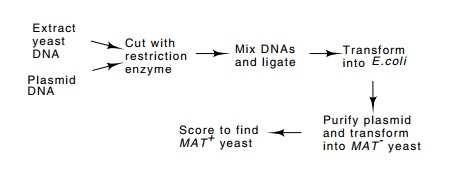Chapter: Genetics and Molecular Biology: Regulation of Mating Type in Yeast
Cloning the Mating Type Loci in Yeast
Cloning the Mating Type Loci in Yeast
How could the existence of reference copies of
mating-type information at HML and HMR and an expression copy at MAT be proven physically? The most
straightforward proof is simply to clone DNA copies from the three loci and use
Southern transfers to show that the DNA occupying the MAT locus comes from HML
or HMR and changes with a shift in
mating type.
Cloning the mating-type loci required both a
convenient genetic selection for the presence of mating-type genes and a
suitable vector. Due to the low efficiency of yeast transformation,
unreasonably large
Figure
16.3 Scheme for cloning yeast mating
type genes.

quantities of yeast DNA, restriction enzymes, and
ligase would have been required if investigators had tried directly to
transform yeast. Instead, the yeast DNA was ligated into a bacterial-yeast
shuttle vector, transformed into bacteria, amplified to suitable levels,
extracted, and this was used to transform the yeast (Fig. 16.3).
The genetic selection for mating-type DNA was
straightforward. The source DNA derived from yeast capable of mating, that is,
having a functional MAT locus. The
amplified plasmid DNA was transformed into a yeast strain possessing a defect
in the MAT locus causing sterility.
Therefore, after the transformation, the yeast having received a plasmid
carrying the MAT locus would become
capable of mating and could easily be detected. The plasmid could then be
isolated from the yeast and transferred into E. coli for amplification.
Related Topics